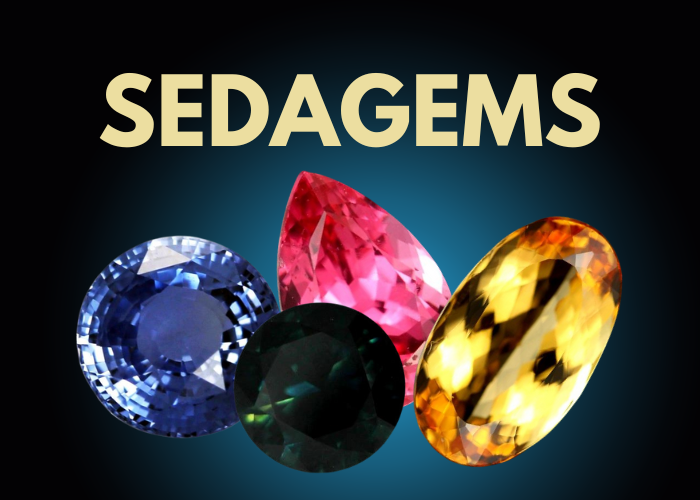12.35 CTS ALEXANDRITE - SPECIMEN FROM TANZANIA [S-SAFE252]
- UGS
- Dimensions (mm)
- 14.000 x 9.000 x 5.000mm
- Poids (cts)
- 12.350
- Taper
- Specimen
- Couleurs
-
ALEXANDRITE SPECIMEN
This is a natural untreated Alexandrite specimen from Tanzania which i bought from the miner on my last trip there. They are not suitable for faceting but can be cabbed or kept as a specimen.
The most sensational feature about this stone, however, is its surprising ability to change its colour. Green or bluish-green in daylight, alexandrite turns a soft shade of red, purplish-red or raspberry red in incandescent light. This unique optical characteristic makes it one of the most valuable gemstones of all, especially in fine qualities.
Alexandrite is very scarce: this is due to its chemical composition. It is basically a chrysoberyl, a mineral consisting of colourless or yellow transparent chrysoberyl, chrysoberyl cat’s eye and colour-changing alexandrite (also in cat’s eye varieties). It differs from other chrysoberyls in that it not only contains iron and titanium, but also chromium as a major impurity. And it is this very element which accounts for the spectacular colour change. Rarely, vanadium may also play a part. According to CIBJO nomenclature, only chrysoberyls displaying a distinct change of colour may be termed alexandrite.
Like many other gemstones, alexandrite emerged millions of years ago in a metamorphic environment. But unlike many others, its formation required specific geological conditions. The chemical elements beryllium (a major constituent in chrysoberyl) and chromium (the colouring agent in alexandrite) have contrasting chemical characteristics and do not as a rule occur together, usually being found in contrasting rock types. Not only has Nature brought these contrasting rock types into contact with each other, but a lack of the chemical element silica (the second most common element in the Earth’s crust) is also required to prevent the growth of emerald. This geological scenario has occurred only rarely in the Earth’s history and, as a result, alexandrite crystals are very scarce indeed.
- UGS
- Dimensions (mm)
- 14.000 x 9.000 x 5.000 mm
- Poids (cts)
- 12.350
- Taper
- Specimen
- Couleurs
-
ALEXANDRITE SPECIMEN
This is a natural untreated Alexandrite specimen from Tanzania which i bought from the miner on my last trip there. They are not suitable for faceting but can be cabbed or kept as a specimen.
The most sensational feature about this stone, however, is its surprising ability to change its colour. Green or bluish-green in daylight, alexandrite turns a soft shade of red, purplish-red or raspberry red in incandescent light. This unique optical characteristic makes it one of the most valuable gemstones of all, especially in fine qualities.
Alexandrite is very scarce: this is due to its chemical composition. It is basically a chrysoberyl, a mineral consisting of colourless or yellow transparent chrysoberyl, chrysoberyl cat’s eye and colour-changing alexandrite (also in cat’s eye varieties). It differs from other chrysoberyls in that it not only contains iron and titanium, but also chromium as a major impurity. And it is this very element which accounts for the spectacular colour change. Rarely, vanadium may also play a part. According to CIBJO nomenclature, only chrysoberyls displaying a distinct change of colour may be termed alexandrite.
Like many other gemstones, alexandrite emerged millions of years ago in a metamorphic environment. But unlike many others, its formation required specific geological conditions. The chemical elements beryllium (a major constituent in chrysoberyl) and chromium (the colouring agent in alexandrite) have contrasting chemical characteristics and do not as a rule occur together, usually being found in contrasting rock types. Not only has Nature brought these contrasting rock types into contact with each other, but a lack of the chemical element silica (the second most common element in the Earth’s crust) is also required to prevent the growth of emerald. This geological scenario has occurred only rarely in the Earth’s history and, as a result, alexandrite crystals are very scarce indeed.
| Fournisseur d'expédition | Expédition vers Australia | Expédition dans le reste du monde |
|---|---|---|
| FedEx | $12.00 / 3 | $39.00 / 10 |
|
Australia
FedEx bénéficie d'une remise de $12.00 sur les commandes contenant 2 ou plus d'articles
Reste du monde
FedEx bénéficie d'une remise de $39.00 sur les commandes contenant 2 ou plus d'articles
|
||
| Registered Shipping | $9.00 / 7 | $16.00 / 21 |
|
Australia
Registered Shipping bénéficie d'une remise de $9.00 sur les commandes contenant 2 ou plus d'articles
Reste du monde
Registered Shipping bénéficie d'une remise de $16.00 sur les commandes contenant 2 ou plus d'articles
|
||

-
 Positif
PositifGood stone great service
-
 Positif
PositifGreat thank very much, lovely pearls.
-
 Positif
PositifNice piece of rough. thankyou
-
 Positif
PositifNice stone. Thankyou
-
 Positif
PositifHave received the rough. Nice colour. Thankyou
Audit
-
Description Précis
-
Images précises
Comments
The Verified Seller has provided accurate and honest pictures and details for this listing. Gem Rock Auctions is committed to holding our sellers to the highest standards of integrity and transparency. As part of this policy, we only permit the sale of natural, earth mined, gemstones. Many Gemstones have received treatments to enhance their color or clarity to further emphasize their beauty and we insist treatments are disclosed. Manmade, synthetic, and imitation gemstones are not permitted on Gem Rock auctions.




![2.95 CTS AUSTRALIAN ROUGH SAPPHIRE [SAP547]](https://liveplatforms-production.b-cdn.net/tenants/gr/uploads/images/685000-689999/689106/599d2324a1992.jpg?width=480&aspect_ratio=1001%3A1000)
![AAA GRADE ROUND PEARL PARCEL HIGH LUSTER- 7 MM [PF2206]](https://liveplatforms-production.b-cdn.net/tenants/gr/uploads/images/245000-249999/245364/245364_1319605247.jpg?width=480&aspect_ratio=1001%3A1000)


![3.10 CTS MINT GREEN GLOSSULAR GARNET ROUGH [F5077]](https://liveplatforms-production.b-cdn.net/tenants/gr/uploads/images/415000-419999/419109/536873d918eb0.JPG?width=480&aspect_ratio=1001%3A1000)





